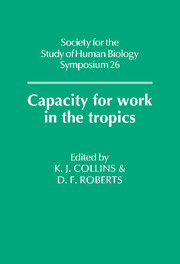Book contents
- Frontmatter
- Contents
- Preface
- Measurement of Working Capacity in Populations
- Work capacity: methodology in a tropical environment
- Ventilatory capacity in tropical populations: constitutional and environmental influences
- Is measurement of aerobic capacity a realistic objective?
- Functional Consequences of Malnutrition
- Growth, Stature and Muscular Efficiency
- Ethnic and Socio-Cultural Differences in Working Capacity
- Energy Expenditure and Endemic Disease
- Research Models in Tropical Ecosystems
- Index
Ventilatory capacity in tropical populations: constitutional and environmental influences
Published online by Cambridge University Press: 15 March 2010
- Frontmatter
- Contents
- Preface
- Measurement of Working Capacity in Populations
- Work capacity: methodology in a tropical environment
- Ventilatory capacity in tropical populations: constitutional and environmental influences
- Is measurement of aerobic capacity a realistic objective?
- Functional Consequences of Malnutrition
- Growth, Stature and Muscular Efficiency
- Ethnic and Socio-Cultural Differences in Working Capacity
- Energy Expenditure and Endemic Disease
- Research Models in Tropical Ecosystems
- Index
Summary
INTRODUCTION
Physical working capacity is largely determined by the individual's aerobic capacity or maximal oxygen uptake (VO2 max). This in its turn depends upon the capacities of a linked series of oxygen transfer functions: diffusion through tissues, circulation of haemoglobin, but first of all pulmonary ventilation. It is the capacity of this primary process of ventilatory function with particular application to tropical populations which is the subject of this paper.
The capacity of the ventilatory system can be measured directly as maximum voluntary ventilation or maximum sustainable ventilation, but it is commonly assessed using single-breath tests. The most convenient measurements are of forced vital capacity (FVC), which reflects the volume of the thorax and the strength of the respiratory muscles, and the forced expired volume in one second (FEV∧), which depends on the FVC and also upon the calibre of the airways.
The first question to ask is: what relevance do these indices of ventilatory capacity have for working capacity? That can be answered in two ways: first by comparing mean values for ventilatory capacity between populations having widely different aerobic capacities. In the preparatory stages of the IBP Human Adaptability programme, Cotes and Davies (1969) measured the aerobic capacities of three European groups: male and female factory workers and some elite athletes. Their VO2 max was 2.2, 3.4 and 4.6 1/min respectively.
- Type
- Chapter
- Information
- Capacity for Work in the Tropics , pp. 31 - 50Publisher: Cambridge University PressPrint publication year: 1988



